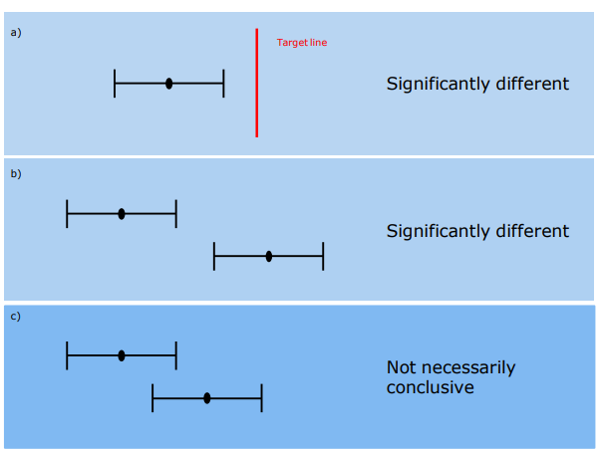Interpretation guide
Please find guidance on how to interpret the following terms used in the tool:
Confidence intervals are indications of the natural variation that would be expected around a rate and they should be considered when assessing or interpreting a rate. The size of the confidence interval is dependent on the number of events occurring and the size of the population from which the events came. Generally speaking, rates based on small numbers of events and small populations are likely to have wider confidence intervals. Conversely, rates based on large populations are likely to have narrower confidence intervals. In the PHOF reporting tool we use 95 per cent confidence intervals. This represents a range of values that we can be 95 per cent confident contains the ‘true’ underlying rate. Comparisons are often made between two or more estimates, for example between different areas or time periods (Figure 1). Sometimes in such cases statistical testing is undertaken by comparing the confidence intervals of the estimates to see if they overlap. Non-overlapping confidence intervals are considered as statistically significantly different (Figures 1a & 1b). Whilst it is safe to assume that non-overlapping confidence intervals indicate a statistically significant difference, it is not always the case that overlapping confidence intervals do not (Figure 1c). A more exact approach is to calculate the ratio of the two estimates, or the difference between them, and construct a test or confidence interval based on that statistic. Such methods are not covered in this technical guide, but can be found in a standard textbook.

Figure 1. Using confidence intervals for making comparisons a) & b) Non- overlapping confidence intervals are considered as statistically significant c) Overlapping confidence intervals do not always indicate a difference that is not statistically significant
- Local and national deprivation fifths
The Welsh Index of Multiple Deprivation (WIMD) is an official measure of relative deprivation for small areas in Wales and a National Statistic. It identifies areas with the highest concentrations of deprivation. Ranking these areas, and dividing them into five equally sized groups produces fifths of deprivation.
For all national level analysis and most of the analysis at health board and local authority, fifths are calculated at the Wales level (national fifths). There are some indicators where local fifths are used, specifically the life expectancy and healthy life expectancy. Local fifths differ from the national fifths in that the five equal bands of deprivation are recalculated just for the small areas within each health board and local authority boundary, rather than inheriting the national fifths. This is useful for a more localised approach to producing health expectancies.
- Revised European Standard Population 2013 is a hypothetical population structure used in the weighting of mortality or incidence data to produce age-standardised rates (ASR’s).